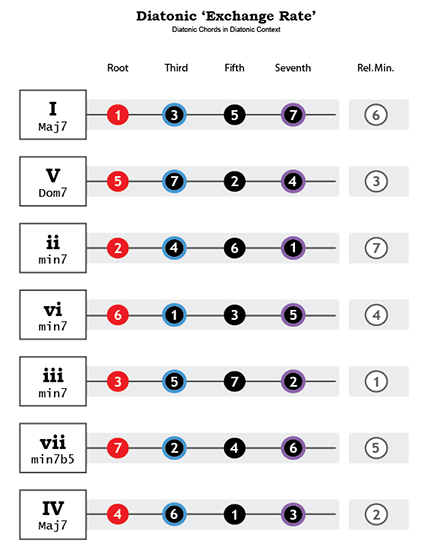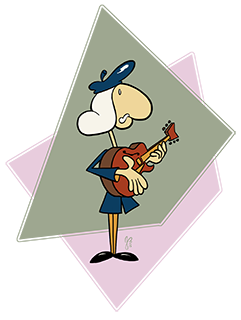- Natural Minor
- Harmonic Minor
- Melodic Minor
First I need to get these minors straight!
Natural Minor
- same as Aeolian mode
- has all notes of the major scale
- is the sixth degree of the major scale
- its arpeggio has the same notes as a C6 arpeggio
- has all the notes of the min7b5 arpeggio
- has a flat seven
- has a flat 13 (flat 6), which is the b9 of the V chord
Harmonic Minor
- has a Major 7 (only difference from Natural/Aeolian)
- has the two fret 'gap' between the M7 and b13
- has a flat 13, which is the b9 of the V chord
- has the flat 5, and all the notes of a min7b5 arpeggio
Melodic Minor
- has a Major 7 (only difference from the Dorian mode)
- it is also the same as a Major scale with a b3
- the seventh mode of this scale is known as the 'Altered' Scale (good for Altered Dominants)
- Has a Perfect 13 (P6), which means no b9 for an Altered Dominant
- does not have b5 of the min7b5 chord, so bad for half-diminished
- best suited for Minor/Major chords or Minor 6 chords
In light of this, Harmonic minor works very nicely for the ii-min7b5 and the V7b9, while the Melodic minor works well at Major-minor tonic resolution.
The other approach is to use the second mode of the Harmonic minor for the ii chord and then use the Altered Scale (7th mode of the Melodic minor) for the Altered Dominant V chord, then return to the Melodic minor for the tonic.
In the first approach, there is only one note that is really differing -- the tonic's b13 moves to the Perfect 13.
The second approach is a bit more difficult because you are moving the same scale around and then back. Quite a number of notes are changing only for one measure or half a measure.
A while ago, I began to learn how to superimpose the Altered scale of the V over all the Major mode boxes, but that knowledge is out the window for a minor ii-V.
If you know that a minor key is the 6th of the major, then you'd think it would follow that the minor progression would essentially be a vii-iii-vi progression. This is not the case. The minor progression is 'harmonized' through the Harmonic minor scale. When you build chords off the Harmonic minor, the iii is really a Dominant -- the 'iii' is really a Dominant.
This means, if you are trying to picture the minor key as the sixth of a major, the root-6 Altered scale for the V is going to be where the Phrygian is, instead of where the Mixolydian would be.
Instead, you have to picture a whole new set of mode boxes on your fretboard -- that of the Harmonic minor -- and then figure out how the Altered scale (or the melodic minor moved one fret up) goes on top of that! That's a lot of mental gymnastics!
It is probably a good idea to be able to picture various modes of the Harmonic minor for a key. More importantly, it is good to know your arpeggios and what notes around those notes cause the most tension and which notes are avoid notes. You probably want to avoid the b9 of the tonic.
The Harmonic minor will be good to learn up and down the neck. Did you know all the notes of a Dominant 7 arpeggio are in the third mode of the melodic minor as well as the fifth mode?
If you calculate a 'diatonic exchange rate' for the minor ii-V-i, you see that the b13 of the minor tonic is the b9 of the V chord. Similarly, the b13 of the minor tonic is also the b5 of the ii chord, so it is a great note to hit over a minor ii-V.
I'm going to focus on using the Harmonic minor over minor ii-V's and practice picturing how they sit over the Natural minor scale (Aeolian mode) across all my mode boxes. Then I would feel more confident about shifting to the Altered scale for my dominant.
Below I tried to illustrate where the notes are on all three minors, visualizing through the root-6 mode boxes.
| theminors.pdf |


 RSS Feed
RSS Feed
